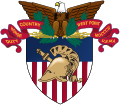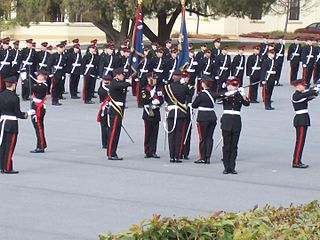
A military academy or service academy is an educational institution which prepares candidates for service in the officer corps. It normally provides education in a military environment, the exact definition depending on the country concerned.

The United States Military Academy (USMA), also known metonymically as West Point or simply as Army, is a United States service academy in West Point, New York. It was originally established as a fort, since it sits on strategic high ground overlooking the Hudson River with a scenic view, 50 miles (80 km) north of New York City. It is the oldest of the five American service academies and educates cadets for commissioning into the United States Army.
Second lieutenant is a junior commissioned officer military rank in many armed forces.

The Royal Military Academy Sandhurst, commonly known simply as Sandhurst, is one of several military academies of the United Kingdom and is the British Army's initial officer training centre. It is located in the town of Sandhurst, Berkshire, though its ceremonial entrance is in Camberley, Surrey, southwest of London. The academy's stated aim is to be "the national centre of excellence for leadership". All British Army officers, including late-entry officers who were previously Warrant Officers, as well as other men and women from overseas, are trained at the academy. Sandhurst is the British Army equivalent of the Britannia Royal Naval College and the Royal Air Force College Cranwell.
An officer candidate school (OCS) is a military school which trains civilians and enlisted personnel in order for them to gain a commission as officers in the armed forces of a country. How OCS is run differs between countries and services. Typically, officer candidates have already attained post-secondary education, and sometimes a bachelor's degree, and undergo a short duration of training which focuses primarily on military skills and leadership. This is in contrast with a military academy which includes academic instruction leading to a bachelor's degree.

The Royal Military College (RMC), founded in 1801 and established in 1802 at Great Marlow and High Wycombe in Buckinghamshire, England, but moved in October 1812 to Sandhurst, Berkshire, was a British Army military academy for training infantry and cavalry officers of the British and Indian Armies.
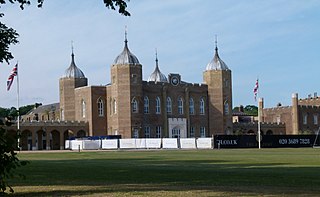
The Royal Military Academy (RMA) at Woolwich, in south-east London, was a British Army military academy for the training of commissioned officers of the Royal Artillery and Royal Engineers. It later also trained officers of the Royal Corps of Signals and other technical corps. RMA Woolwich was commonly known as "The Shop" because its first building was a converted workshop of the Woolwich Arsenal.
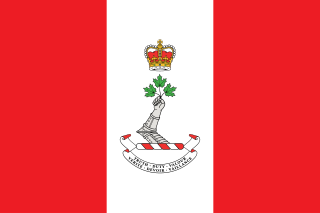
The Royal Military College(s) of Canada, abbreviated in English as RMC and in French as CMR, is a military academy and, since 1959, a degree-granting university of the Canadian Armed Forces. It was established in 1874 and conducted its first classes on June 1, 1876. Presently, it is the only federal institution in Canada with degree-granting powers; the Government of Ontario empowered RMC to confer degrees in the arts, science, and engineering through The Royal Military College of Canada Degrees Act, 1959. Programs are offered at the undergraduate and graduate levels, both on campus as well as through the college's distance learning programme via the Division of Continuing Studies.

The Royal Military College, Duntroon, also known simply as Duntroon, is the Australian Army's officer training establishment. It was founded at Duntroon, in Canberra, Australian Capital Territory, in 1911 and is at the foot of Mount Pleasant near Lake Burley Griffin, close to the Department of Defence headquarters at Russell Hill. It is comparable to the United Kingdom's Royal Military Academy Sandhurst and the United States Military Academy at West Point. Duntroon is adjacent to the Australian Defence Force Academy (ADFA), which is Australian Defence Force's tri-service military academy that provides military and tertiary academic education for junior officers of the Australian Army, Royal Australian Air Force and the Royal Australian Navy.

Colour sergeant is a rank of non-commissioned officer found in several armies and marine corps.
Under officer is an appointment held by the most senior cadets at some Commonwealth officer training establishments and in University Officers' Training Corps in the United Kingdom, and also a rank used in some Commonwealth cadet forces.
Officer Cadet is a rank held by military cadets during their training to become commissioned officers. In the United Kingdom, the rank is also used by members of University Royal Naval Units, University Officer Training Corps and University Air Squadron; however, these are not trainee officers with many not choosing a career in the armed forces.

The RMC Paladins are the athletic teams that represent Royal Military College of Canada in Kingston, Ontario, Canada. Its facilities include the Kingston Military Community Sport Centre (KMCSC) with seating for 3737, the Navy Bay fields with seating for 800 and Constantine Arena with seating for 1500 and the Birchall Pavilion.
An obstacle course is a series of challenging physical obstacles an individual, team or animal must navigate, usually while being timed. Obstacle courses can include running, climbing, jumping, crawling, swimming, and balancing elements with the aim of testing speed, endurance and agility. Sometimes a course involves mental tests. The idea has been adapted into TV shows and video games
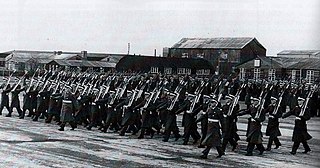
Passing out is the official graduation ceremony following the completion of a course by military or other uniformed service personnel at their respective training school, college, or military academy, largely in Commonwealth nations. Soldiers, sailors, or airmen take part in a passing out military parade upon completion of a basic training course. The military parade during the 'passing out' ceremony may also consist of military bands, and other displays of synchronisation discipline such as a flypast, which may also include acrobatics.
Royal Marines Cadets (SCC) are part of the Sea Cadets, a United Kingdom uniformed youth organization was formed in 1955 by the then Commandant General Royal Marines – General Sir Campbell Richard Hardy, KCB, CBE, DSO & Bar. It could be said that The Royal Marines Cadets are a hybrid between the all important cadet experience and benefits of a Sea Cadet and that of an Army Cadet, but it is so much more than that. It is a unique opportunity to learn and develop personal skills and attributes in leadership, teamwork and self-discipline. They take part in all the waterborne activities, as well as branching off into adventure training and military skills too. The Royal Marines Cadets of the SCC specialise in activities such as orienteering, fieldcraft, and weapon handling.

The Department of Physical Education is the academic department that oversees the physical development program at the United States Military Academy at West Point, New York. DPE is headquartered in the Arvin Cadet Physical Development Center. DPE has 24 Military faculty and 25 civilian instructors and professors. The head of the department holds the ceremonial title of Master of the Sword, known within the department as the MOS. This title dates back to when the Cadets at West Point were taught swordsmanship as part of their military and physical training. The current Master of the Sword is COL Nicholas Gist, who has held the position since 2015. The department's stated mission is:
The Department of Physical Education develops warrior leaders of character who are physically and mentally tough by engaging cadets in activities that promote and enhance a healthy lifestyle, physical fitness, movement behavior, and psychomotor performance.
Mons Officer Cadet School was a British military training establishment for officer cadets in Aldershot from 1942 to 1972, when it was closed and all officer training concentrated at Sandhurst.

The Royal Military College of Canada Bands is the official group of bands of the Royal Military College of Canada. The group is composed of four sections: the brass and reed, the pipes and drums, highland dancers, and choristers. Total band membership consists of 105 Officer Cadets from the college. Officer Cadets in the band practice three days a week in the morning on top of attending their individual full-time university programs.
















